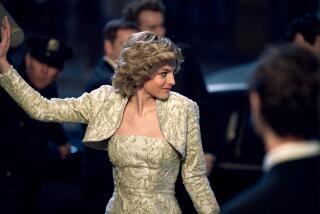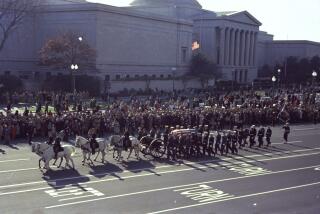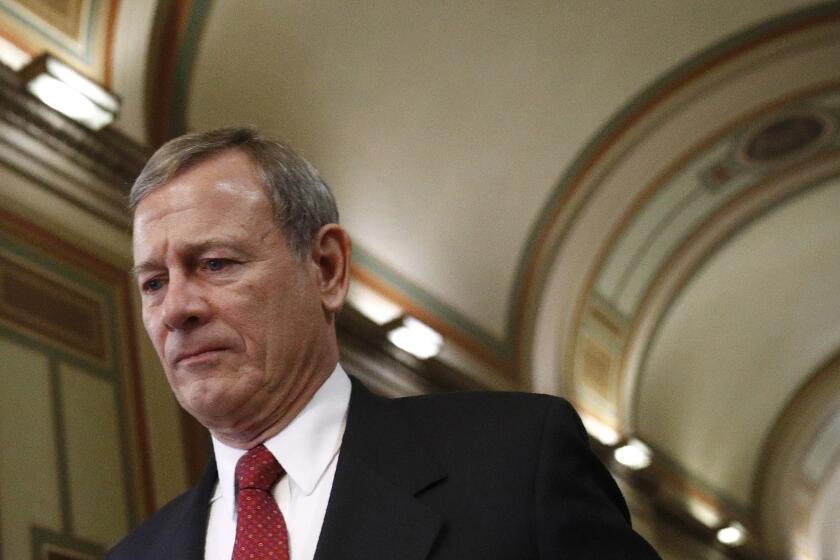For Layman, Bearing Cross Was No Burden
- Share via
LONDON — He sang at the coronation of Queen Elizabeth II, carried the cross for the wedding of Prince Andrew and Sarah Ferguson, helped out at the funeral of Lord Louis Mountbatten, and watched all manner of ceremony and dignitary from a unique fly-on-the-wall perspective.
But James Wilkinson, the 55-year-old layman who carried the cross at the head of Princess Diana’s funeral procession, said he had never experienced anything like Saturday’s ceremony.
“This was by far the most extraordinary service I’ve ever been to,” said Wilkinson, a quiet-spoken man who was selected to walk the length of Westminster Abbey just ahead of Diana’s coffin as it entered and left the nave. “I don’t think it’s over the top to say it was a work of art.”
Dressed in a cassock and richly embroidered antique tunicle, Wilkinson played a small, but visually prominent, role in a ceremony whose every detail was carefully chosen for its potential to turn the grief of millions into feelings of hope and thanksgiving. He carried a large ivory cross made of an elephant tusk given to Westminster Abbey years ago by the last emperor of Ethiopia, Haile Selassie.
Despite extensive rehearsing Friday, and despite his years of experience with ceremonial occasions, Wilkinson said, he would never forget the way he felt as he stood by the abbey’s west door Saturday, waiting to receive Diana’s coffin as a single bell rang and the organist began to play a Bach fantasia.
The music, the sight of the Royal Standard and lilies on Diana’s approaching coffin and the hollow crunching of the pallbearers’ hobnailed boots on the abbey’s centuries-old stone floor all came together in a powerful new way for him.
“I had a lump in my throat,” he said. “It was the most remarkable service I’ve ever been to because the congregation was far more involved” than is usual in formal ceremonies at the abbey. “There weren’t a lot of soldiers and ambassadors and politicians there. People were there because they loved her.”
For Wilkinson, a science journalist who calls himself “just an ordinary hack” and spends his weekdays covering such worldly events as the Mars probe and the misadventures of the Mir space station, Saturday’s funeral was the culmination of a church-centered life, begun as a boy.
He entered the Westminster School at the age of 6, becoming one of the 36 choristers that the abbey has selected each year since Elizabethan times to live within its deanery walls, receive intensive musical instruction and sing for religious services each day.
He happened to be at the school in 1953, when Queen Elizabeth was crowned, and said the huge crowds that turned out to mourn Diana were unrivaled by anything he has seen since that far happier day, when he and the other choirboys amused themselves by lowering a basket labeled “Sweets, please” on a rope from their dormitory window, hoping to cadge candy from some of the new queen’s well-wishers.
The headmaster quickly broke up that mischief, but the queen rewarded Wilkinson and the other small choristers with a medal, which he has saved to this day. He said he plans to keep the order of service for Diana’s funeral along with it.
Though Wilkinson left the abbey boarding school when he was about 13, completed his education and went to work first for a London newspaper and later for the BBC, his heart never really left the abbey. He joined the Brotherhood of St. Edward, a small lay organization that carries alms dishes, banners, candles and other ceremonial objects during services at the abbey. He also participates in a club of former choristers that takes select groups of amateur historians and music lovers through the abbey in the evenings, singing for them and trying to share with them some of the 750-year-old building’s secrets.
Wilkinson said it was because of these years of lay activity that he was chosen to carry the cross for Diana, something he called “a privilege” but that he admitted gave him terrific stomach butterflies.
“I was quite nervous about carrying the cross at the end of the service because it was such a prominent position,” he said. “It would be awful to drop it. But everything came off without a hitch. The service was constructed in such a way that it was very intimate, and you could forget that it was being watched by 2 1/2 billion people.”
And how did Wilkinson the journalist feel, hearing his workaday fellows scorned as “the opposite end of the moral spectrum” from Diana’s “genuine goodness” by her brother, in a strongly worded tribute that was singled out by many after the funeral as one of the defining moments of the day? Was he hurt? Did he think the bitter words were inappropriate for a house of worship?
On the contrary. “It was absolutely cracking. Brilliant,” said Wilkinson, who listened to the earl’s tribute from a seat next to the pulpit.
“I think he has a good reason to be angry over the way newspapers have treated Diana ever since she started out,” he said. “I do think they chased her. They hunted her. They sneered at her, as he said.”
To his own surprise, he found himself applauding the Earl Spencer, along with the rest of the congregation.
More to Read
Sign up for Essential California
The most important California stories and recommendations in your inbox every morning.
You may occasionally receive promotional content from the Los Angeles Times.










